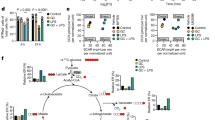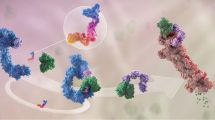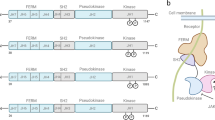Abstract
PAD4 has been strongly implicated in the pathogenesis of autoimmune, cardiovascular and oncological diseases through clinical genetics and gene disruption in mice. New selective PAD4 inhibitors binding a calcium-deficient form of the PAD4 enzyme have validated the critical enzymatic role of human and mouse PAD4 in both histone citrullination and neutrophil extracellular trap formation for, to our knowledge, the first time. The therapeutic potential of PAD4 inhibitors can now be explored.
This is a preview of subscription content, access via your institution
Access options
Subscribe to this journal
Receive 12 print issues and online access
$259.00 per year
only $21.58 per issue
Buy this article
- Purchase on Springer Link
- Instant access to full article PDF
Prices may be subject to local taxes which are calculated during checkout



Similar content being viewed by others
References
Jones, J.E., Causey, C.P., Knuckley, B., Slack-Noyes, J.L. & Thompson, P.R. Curr. Opin. Drug Discov. Devel. 12, 616–627 (2009).
Brinkmann, V. et al. Science 303, 1532–1535 (2004).
Ohlsson, S.M. et al. Clin. Exp. Immunol. 176, 363–372 (2014).
Hakkim, A. et al. Proc. Natl. Acad. Sci. USA 107, 9813–9818 (2010).
Villanueva, E. et al. J. Immunol. 187, 538–552 (2011).
Martinod, K. et al. Proc. Natl. Acad. Sci. USA 110, 8674–8679 (2013).
Clark, S.R. et al. Nat. Med. 13, 463–469 (2007).
Li, P. et al. J. Exp. Med. 207, 1853–1862 (2010).
Knuckley, B. et al. Biochemistry 49, 4852–4863 (2010).
Luo, Y. et al. Biochemistry 45, 11727–11736 (2006).
Causey, C.P. et al. J. Med. Chem. 54, 6919–6935 (2011).
Jones, J.E. et al. ACS Chem. Biol. 7, 160–165 (2012).
Wang, Y. et al. J. Biol. Chem. 287, 25941–25953 (2012).
Clark, M.A. et al. Nat. Chem. Biol. 5, 647–654 (2009).
Luo, Y., Knuckley, B., Lee, Y.H., Stallcup, M.R. & Thompson, P.R. J. Am. Chem. Soc. 128, 1092–1093 (2006).
Arita, K. et al. Nat. Struct. Mol. Biol. 11, 777–783 (2004).
Linsky, T. & Fast, W. Biochim. Biophys. Acta 1804, 1943–1953 (2010).
Humm, A., Fritsche, E., Steinbacher, S. & Huber, R. EMBO J. 16, 3373–3385 (1997).
Hakkim, A. et al. Nat. Chem. Biol. 7, 75–77 (2011).
Li, P. et al. Mol. Cell. Biol. 28, 4745–4758 (2008).
Li, P. et al. Oncogene 29, 3153–3162 (2010).
Slack, J.L., Jones, L.E. Jr., Bhatia, M.M. & Thompson, P.R. Biochemistry 50, 3997–4010 (2011).
Kearney, P.L. et al. Biochemistry 44, 10570–10582 (2005).
Darrah, E. et al. Sci. Transl. Med. 5, 186ra65 (2013).
Lewallen, D.M. et al. ACS Chem. Biol. 9, 913–921 (2014).
Sugawara, K. & Oyama, F. J. Biochem. 89, 771–774 (1981).
Young, R.J., Green, D.V., Luscombe, C.N. & Hill, A.P. Drug Discov. Today 16, 822–830 (2011).
Emsley, P., Lohkamp, B., Scott, W.G. & Cowtan, K. Acta Crystallogr. D Biol. Crystallogr. 66, 486–501 (2010).
Murshudov, G.N. et al. Acta Crystallogr. D Biol. Crystallogr. 67, 355–367 (2011).
Smart, O.S. et al. Acta Crystallogr. D Biol. Crystallogr. 68, 368–380 (2012).
Adams, P.D. et al. Acta Crystallogr. D Biol. Crystallogr. 66, 213–221 (2010).
Demers, M. et al. Proc. Natl. Acad. Sci. USA 109, 13076–13081 (2012).
Bantscheff, M. et al. Nat. Biotechnol. 25, 1035–1044 (2007).
Bouwmeester, T. et al. Nat. Cell Biol. 6, 97–105 (2004).
Fuchs, T.A. et al. J. Cell Biol. 176, 231–241 (2007).
Acknowledgements
This work was supported in part by US National Institutes of Health grants GM079357 (to P.R.T.) and R01 HL102101 (to D.D.W.). We thank the following colleagues for their medicinal and synthetic chemistry contributions to this manuscript: D. Amans, H. Diallo, C. Douault, N. Garton, K. Jones, J. Renaux, T. Shipley, A. Walker, B. Watson and C. Wellaway. We also gratefully acknowledge S. Ready for diligently preparing and quantifying S. aureus for neutrophil studies. For the chemoproteomics data, we would like to thank M. Boesche and Cellzome's tissue culture and target validation teams for technical expertise and M. Bantscheff for stimulating discussion. We thank M. Neu and P. Homes for assistance for structural studies and B. Nolte for advice on crystallography.
Author information
Authors and Affiliations
Contributions
H.D.L., J.L. and J.E.C. led the project, designed the research, interpreted data and drafted the manuscript with input from all authors. S.J.A., M.D.B., M.C., R.J.S. and D.M.W. synthesized or designed key compounds. K.E.L., C.E.R. and G.Y. performed and analyzed the screening, which identified the PAD4 inhibitors. K.L.B., R.P.B., P.D.C., K.L. and D.J.S. designed the biochemical assays and deduced the mechanism of action of compounds. D.E., G.J. and G.D. generated chemoproteomic data. Y.H.C., R.P.D., D.E., C.M., K.M., C.P. and M.R. performed cellular assays. For structures, O.P. purified protein; J.T. crystallized protein, soaked crystals and collected data; B.D.B. refined structures; and P.T. performed sequence and structural analysis. C.-w.C. D.D.W., P.R.T., R.K.P. and D.M.W. guided aspects of this work. C.M., S.J.A., C.-w.C. and H.D.L. also contributed invaluably to the revision and formatting of the final manuscript.
Corresponding author
Ethics declarations
Competing interests
P.R.T. is a co-founder and consultant to Padlock Therapeutics. The majority of the other authors are pharmaceutical industry employees and shareholders.
Supplementary information
Supplementary Text and Figures
Supplementary Results, Supplementary Figures 1–19 and Supplementary Tables 1–6. (PDF 9590 kb)
Supplementary Note
General Procedures (PDF 1514 kb)
Rights and permissions
About this article
Cite this article
Lewis, H., Liddle, J., Coote, J. et al. Inhibition of PAD4 activity is sufficient to disrupt mouse and human NET formation. Nat Chem Biol 11, 189–191 (2015). https://doi.org/10.1038/nchembio.1735
Received:
Accepted:
Published:
Issue Date:
DOI: https://doi.org/10.1038/nchembio.1735
This article is cited by
-
Role and intervention of PAD4 in NETs in acute respiratory distress syndrome
Respiratory Research (2024)
-
Alleviation of arthritis through prevention of neutrophil extracellular traps by an orally available inhibitor of protein arginine deiminase 4
Scientific Reports (2023)
-
Death of tonsillar B cells by NETosis
Cell Death Discovery (2023)
-
Balancing the functions of DNA extracellular traps in intracellular parasite infections: implications for host defense, disease pathology and therapy
Cell Death & Disease (2023)
-
Neutrophil extracellular traps in intracerebral hemorrhage: implications for pathogenesis and therapeutic targets
Metabolic Brain Disease (2023)



